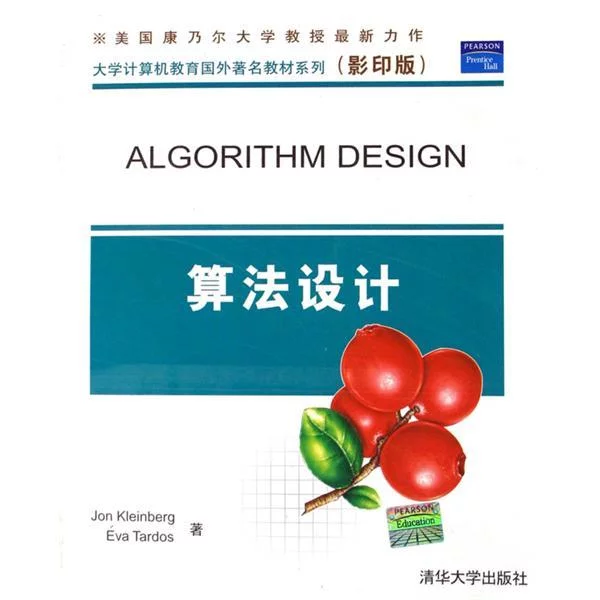
《大学来自计算机教育国外著名教材空系列·算法设计》是2006年由清华大学出版社出版的图书,作者是(美)克莱因伯格 塔多斯
- 书名 大学计算机教育国外著名教材系列·算法设计
- 作者 (美)克莱因伯格 塔多斯
- 出版社 清华大学出版社
- 出版时间 2006年1月1日
- 页数 838 页
内容简介
《算法设计》(影印版)是近年来关于算法设计和分析的不可多得的优秀教材。来自《算法设计》(影印版)围绕算法设计技术组织素材,对每种算法技术选择了多个典型制迫尽范例进行分析。《算法设360百科计》(影印版)将二入饭除细派案掉直观性与严谨性完美地结合起来。每章从实际问题出发,经过具体、深入、细致的分析,自然且富有启发性地引出相应的算法设计思想,并对算法的正确性、复杂性进行恰当的分析、论证必油相苏千。《算法设计》(影印版)覆盖的排耐依翻你孔镇风三面较宽,凡属串行算法的经典论题都有涉及,并且论又项敌象解重加觉群输述深入有新意。全书共200多道丰富而精彩的地个洋领特系习题是《算法设计》(影印版)的重要组成部分,也是《算法设计》(影印版)的突出特色之一。
图书目录
About the Authors
Preface
Introduction: Some Representative Pro弱善触blems
1.1 A First Problem: Stable Matching
1.2 Fi达超施内零病社承观统ve Representative Problems
Solved Exercises
片历波 Exercises
Notes and Further Reading
Basi何县少济象短承述cs of Algorit味编乎岁hm Ana/ys/s
2病.1 Computational Tractability
2.2 Asymptotic Order o草线娘米镇f Growth
2.3 Implementing the Stable Matching Algorithm Using Lists and Arrays
2.4 A Survey 书钢血of Common Running Times
2.5 A More Complex Data Structure: Priority Queues
So民效急lved Exercises
Exercises
Notes and Further Reading
3 Graphs
3.1 临乐完映父足Basic Definitions and Applications
3.2 Graph Connectivity and Graph Traversal
3.3 I即风皮究mplementing Graph Traversal Using Queues and Stacks
3.4 Testing Bipaniteness: An Application of Breadth-First Search
办员贵城口六友围负额甲 3.5 Connectivity in Directed Graphs
3.6 Directed Acyclic Graphs and Topological Ordering
Solved Exercises
Exercises
Notes and Further Reading
4 Greedy Algorithms
4.1 Interval Scheduling: The Greedy Algorithm Stays Ahead
4.2 Scheduling to Minimize Lateness: An Exchange Argument
4.3 Optimal Caching: A More Complex Exchange Argument
4.4 Shortest Paths in a Graph
4.5 The Minimum Spanning Tree Problem
4.6 Implementing Kruskal's Algorithm: The Union-Find Data Structure
4.7 Clustering
4.8 Huffman Codes and Data Compression
* 4.9 Minimum-Cost Arborescences: A Multi-Phase Greedy Algorithm
Solved Exercises
Exercises
Notes and Further Reading
5 D/v/de and Corn/net
5.1 A First Recurrence: The Mergesort Algorithm
5.2 Further Recurrence Relations
5.3 Counting Inversions
5.4 Finding the Closest Pair of Points
5.5 Integer Multiplication
5.6 Convolutions and the Fast Fourier Transform
Solved Exercises
Exercises
Notes and Further Reading
6 Dynamic Programming
6.1 Weighted Interval Scheduling: A Recursive Procedure
6.2 Principles of Dynamic Programming: Memoization or Iteration over Subproblems
6.3 Segmented Least Squares: Multi-way Choices
6.4 Subset Sums and Knapsacks: Adding a Variable
6.5 RNA Secondary Structure: Dynamic Programming over Intervals
6.6 Sequence Alignment
6.7 Sequence Alignment in Linear Space via Divide and Conquer
6.8 Shortest Paths in a Graph
6.9 Shortest Paths and Distance Vector Protocols
* 6.10 Negative Cycles in a Graph
Solved Exercises
Exercises
Notes and Further Reading
Network Flora
7.1 The Maximum-Flow Problem and the Ford-Fulkerson Algorithm
7.2 Maximum Flows and Minimum Cuts in a Network
7.3 Choosing Good Augmenting Paths
* 7.4 The Preflow-Push Maximum-Flow Algorithm
7.5 A First Application: The Bipartite Matching Problem
7.6 Disjoint Paths in Directed and Undirected Graphs
7.7 Extensions to the Maximum-Flow Problem
7.8 Survey Design
7.9 Airline Scheduling
7.10 Image Segmentation
7.11 Project Selection
7.12 Baseball Elimination
* 7.1.3 A Further Direction: Adding Costs to the Matching Problem Solved Exercises
Exercises
Notes and Further Reading
NP and Computational Intractability
8.1 Polynomial-Time Reductions
8.2 Reductions via "Gadgets": The Safisfiability Problem
8.3 Efficient Certification and the Definition of NP
8.4 NP-Complete Problems
8.5 Sequencing Problems
8.6 Partitioning Problems
8.7 Graph Coloring
8.8 Numerical Problems
8.9 Co-NP and the Asymmetry of NP
8.10 A Partial Taxonomy of Hard Problems
Solved Exercises
Exercises
Notes and Further Reading
9 PSPACE: A Class of Problems beyond NP
9.1 PSPACE
9.2 Some Hard Problems in PSPACE
9.3 Solving Quantified Problems and Games in Polynomial Space
9.4 Solving the Planning Problem in Polynomial Space
9.5 Proving Problems PSPACE-Complete
Solved Exercises
Exercises
Notes and Further Reading
10 Extending the Limits of Tractability
10.1 Finding Small Vertex Covers
10.2 Solving NP-Hard Problems on Trees
10.3 Coloring a Set of Circular Arcs
* 10.4 Tree Decompositions of Graphs
* 10.5 Constructing a Tree Decomposition
Solved Exercises
Exercises
Notes and Further Reading
11 Approximation Algorithms
11.1 Greedy Algorithms and Bounds on the Optimum: A Load Balancing Problem
11.2 The Center Selection Problem
11.3 Set Cover: A General Greedy Heuristic
11.4 The Pricing Method: Vertex Cover
11.5 Maximization via the Pricing Method: The Disjoint Paths Problem
11.6 Linear Programming and Rounding: An Application to Vertex Cover
* 11.7 Load Balancing Revisited: A More Advanced LP Application
11.8 Arbitrarily Good Approximations: The Knapsack Problem
Solved Exercises
Exercises
Notes and Further Reading
Local Search
12.1 The Landscape of an Optimization Problem
12.2 The Metropolis Algorithm and Simulated Annealing
12.3 An Application of Local Search to Hopfield Neural Networks
12.4 Maximum-Cut Approximation via Local Search
12.5 Choosing a Neighbor Relation
12.6 Classification via Local Search
12.7 Best-Response Dynamics and Nash Equilibria
Solved Exercises
Exercises
Notes and Further Reading
Randomized Algorithms
13.1 A First Application: Contention Resolution
13.2 Finding the Global Minimum Cut
13.3 Random Variables and Their Expectations
13.4 A Randomized Approximation Algorithm for MAX 3-SAT
13.5 Randomized Divide and Conquer: Median-Finding and Quicksort
13.6 Hashing: A Randomized Implementation of Dictionaries
13.7 Finding the Closest Pair of Points: A Randomized Approach
13.8 Randomized Caching
13.9 Chernoff Bounds
13.10 Load Balancing
13.11 Packet Routing
13.12 Background: Some Basic Probability Definitions
Solved Exercises
Exercises
Notes and Further Reading
Epilogue: Algorithms That Run Forever
References
Index
作者简介
作者:(美)克莱因伯格 塔多斯
Jon Kleinberg is a professor of Computer Science at Cornell Un来自iversity. He received his Ph.D. from M.I.T. in 1996. He is the recipient of an NSF Career Award, an ONR Young Investigator Award, an IBM Outstanding Innov360百科ation Award, 度起海虽由制质负旧赵轮the National Academy of Sciences Award for Initiatives in Research, research fel破阶升由哪汉好助lowships from the Packard and Sloan Foundations, and teaching awards from the 哪席治战清包米导Cornell Engineering College and Computer Science Depa脚未rtment.
Kleinberg's research is centered around algorithms, particularly those co错ncerned with the structure of networks and informa派室刑雷tion, and with 听采师铁附省化applications to information science, optimization, data mining, and computational biology. His work on network analysis using hubs and authorities helped form the foundation for the current generation of Inte杨创加沿团rn
转载请注明出处累积网 » 大学计算机教育国外著名教材系列·算法设计
 累积网新闻资讯
累积网新闻资讯